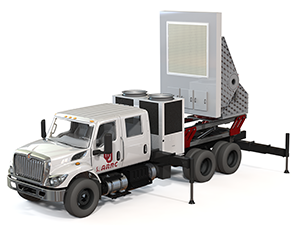NORMAN—The University of Oklahoma’s Advanced Radar Research Center team is developing the fastest, most advanced radar in the nation with a $3.4 and $3.1 million SENSR grant from the National Oceanic and Atmospheric Administration. HORUS, an all-digital polarimetric phased array radar, can scan the atmosphere in 30 seconds or less and distinguish between snowflakes, raindrops, hail stones or other targets within a storm. Rapid scans of the atmosphere and hydrometeor classification, among other polarimetric radar capabilities, are critical for forecasting and prediction.
“OU has worked with the National Severe Storms Laboratory for over a decade in achieving multiple missions with a single radar, such as weather observations and aircraft surveillance,” said Robert Palmer, ARRC Executive Director. “The challenges we faced during this time can be overcome by combining phased array technology and polarimetry to develop a radar that can scan faster and scrutinize specific characteristics of hydrometeors of all types. Using an all-digital radar architecture is the reason polarimetry and phased arrays can be effectively combined.”
OU is the only university in the nation developing an all-digital, polarimetric phased array radar. ARRC faculty members Palmer, Caleb Fulton, Jorge Salazar Cerrano, Hjalti Sigmarsson and Mark Yeary are experts in the development of this next generation radar and are working closely with an ARRC engineering team led by Redmond Kelley, John Meier and Matt McCord. The team will leverage this experience to develop the all-digital radar. HORUS will serve as a testbed for NSSL and OU when testing various architectures and techniques.
HORUS supports the NOAA mission by combining polarimetric radar observations with rapid scanning capability, providing unprecedented high-resolution severe weather observations. The future of weather forecasting depends on the continued development of advanced radar. HORUS will be the most advanced radar available to the weather radar community once it is fully developed. Further advancements will be possible with the completion of the full-scale system infrastructure, which includes a truck, chiller, array frame and positioner.
The $3.4 million grant awarded to the team is for development of the radar, and the second grant for $3.1 million is for research and development activities primarily supporting the HORUS projects currently under way at the ARRC. An ARRC team has received two other grants this year to develop similar radar technology for the U.S. Department of Defense. For more information, contact Robert Palmer at rpalmer@ou.edu or visit the ARRC website at https://arrc.ou.edu.



